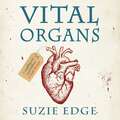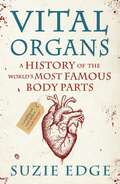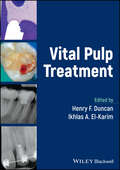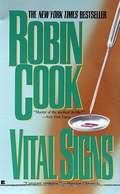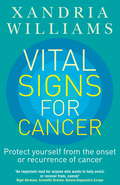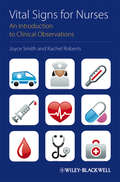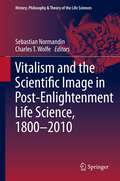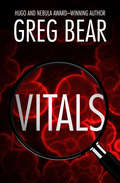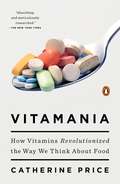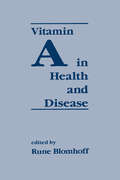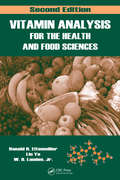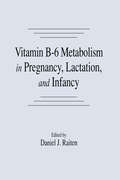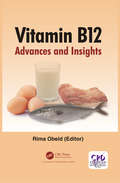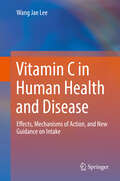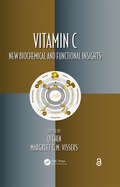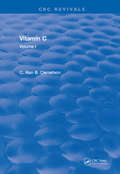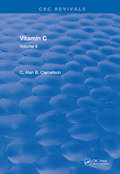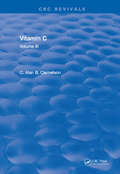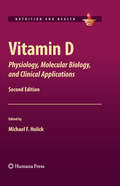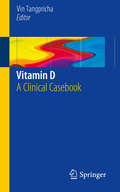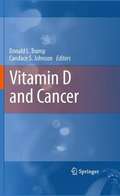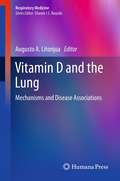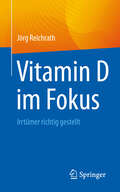- Table View
- List View
Vital Organs
by Suzie EdgeThe remarkable stories of the world's most famous body parts.Louis XIV's rear end inspired the British National Anthem. Queen Victoria's armpit led the development of antiseptics.Robert Jenkin's ear started a war.All too often, historical figures feel distant and abstract; more myth and legend than real flesh and blood. These stories of bodies and its parts remind us that history's most-loved, and most-hated, were real breathing creatures who inhabited organs and limbs just like us - until they're cut off that is.Medical historian Dr Suzie Edge investigates over 40 cases of how we've used, abused, dug up, displayed, experimented on, and worshipped body parts, including why Percy Shelley's heart refused to burn; how Yao Niang's toes started a 1000 year long ritual; why a giant's bones are making us rethink medical ethics; and the strange case of Hitler's right testicle.
Vital Organs
by Suzie EdgeThe remarkable stories of the world's most famous body parts.Louis XIV's rear end inspired the British National Anthem. Queen Victoria's armpit led to the development of antiseptics.Robert Jenkin's ear started a war.All too often, historical figures feel distant and abstract; more myth and legend than real flesh and blood. These stories of bodies and its parts remind us that history's most-loved, and most-hated, were real breathing creatures who inhabited organs and limbs just like us - until they're cut off that is.Medical historian Dr Suzie Edge investigates over 40 cases of how we've used, abused, dug up, displayed, experimented on, and worshipped body parts, including why Percy Shelley's heart refused to burn; how Yao Niang's toes started a 1000 year long ritual; why a giant's bones are making us rethink medical ethics; and the strange case of Hitler's right testicle.
Vital Organs
by Suzie EdgeThe remarkable stories of the world's most famous body parts.Louis XIV's rear end inspired the British National Anthem. Queen Victoria's armpit led to the development of antiseptics.Robert Jenkin's ear started a war.All too often, historical figures feel distant and abstract; more myth and legend than real flesh and blood. These stories of bodies and its parts remind us that history's most-loved, and most-hated, were real breathing creatures who inhabited organs and limbs just like us - until they're cut off that is.Medical historian Dr Suzie Edge investigates over 40 cases of how we've used, abused, dug up, displayed, experimented on, and worshipped body parts, including why Percy Shelley's heart refused to burn; how Yao Niang's toes started a 1000 year long ritual; why a giant's bones are making us rethink medical ethics; and the strange case of Hitler's right testicle.
Vital Pulp Treatment
by Henry F. Duncan Ikhlas A. El-KarimVital Pulp Treatment A comprehensive reference work covering all aspects of vital pulp treatments in clinical practice Vital Pulp Treatment offers a comprehensive overview of existing and developing vital pulp therapies, the science that underpins them as well as their clinical applications. Preserving dental pulp tissue is critical to oral health and vital pulp treatments are designed to maintain, repair, and regenerate this tissue. With a focus on clinical practice, this book begins with the diagnosis and causes of pulpitis before elaborating on the application of vital pulp treatment after trauma, caries, or dental procedures. Later chapters cover a variety of extent treatment modalities including caries removal, pulpotomy, direct or indirect pulp capping and regenerative endodontic therapies. Vital Pulp Treatment readers will also find: Clinical photographs to support and highlight key parts of the text Detailed discussion of topics including pulp diagnostics, deep caries, and pulp exposure management, as well as controversial and clinically relevant discussions Dedicated treatment of each therapeutic modality with a summary of the state of the art in each caseOutcome measures and follow-up guidelines Rooted in evidence-based dentistry and robust scientific research, Vital Pulp Treatment is ideal for dentists, endodontists, restorative dentists, and dental students looking for information on this critical component of modern minimally-invasive dentistry.
Vital Signs
by Robin CookPediatrician Melissa Blumenthal will try any scientific method available to conceive--until the horrible secrets of an urban clinic erupt in a nightmare of staggering proportions...
Vital Signs For Cancer: How to prevent, reverse and monitor the cancer process
by Xandria WilliamsIn VITAL SIGNS, Xandria Williams explains why current medical treatments for cancer are having so little effect. She draws on her research findings, scientific background and work as a nutritionist and naturopath specialising in cancer to help you to understand the cancer process and give expert advice on how you can detect and reverse the cancer process long before a tumour appears. She gives accessible and practical advice on how to avoid cancer and monitor good health, what to do if you are afraid you may have cancer or be at risk of developing cancer, and complementary and alternative (CAM) approaches to follow if you currently have cancer or have just been diagnosed. These can be used safely alongside medical treatment. She also advises on how you can remain cancer free if you are in remission and want to avoid a recurrence.
Vital Signs for Nurses
by Rachel Roberts Joyce SmithAccurate clinical observations are the key to good patient care and fundamental to nursing practice. Vital Signs for Nurses will support anyone in care delivery to enhance their skills, reflect upon their own practice and assist in their continuing professional development. This practical introductory text explores how to make assessments of heart rate, blood pressure, temperature, pain and nutrition. It also looks at issues of infection control, record-keeping and legal and ethical considerations. With case studies and examples throughout, this text will be invaluable to all healthcare assistants, student nurses, Trainee Assistant Practitioners and students on foundation degrees.
Vitalism and Its Legacy in Twentieth Century Life Sciences and Philosophy (History, Philosophy and Theory of the Life Sciences #29)
by Charles T. Wolfe Christopher DonohueThis Open Access book combines philosophical and historical analysis of various forms of alternatives to mechanism and mechanistic explanation, focusing on the 19th century to the present. It addresses vitalism, organicism and responses to materialism and its relevance to current biological science. In doing so, it promotes dialogue and discussion about the historical and philosophical importance of vitalism and other non-mechanistic conceptions of life. It points towards the integration of genomic science into the broader history of biology. It details a broad engagement with a variety of nineteenth, twentieth and twenty-first century vitalisms and conceptions of life. In addition, it discusses important threads in the history of concepts in the United States and Europe, including charting new reception histories in eastern and south-eastern Europe. While vitalism, organicism and similar epistemologies are often the concern of specialists in the history and philosophy of biology and of historians of ideas, the range of the contributions as well as the geographical and temporal scope of the volume allows for it to appeal to the historian of science and the historian of biology generally.
Vitalism and the Scientific Image in Post-Enlightenment Life Science, 1800-2010
by Charles T. Wolfe Sebastian NormandinVitalism is understood as impacting the history of the life sciences, medicine and philosophy, representing an epistemological challenge to the dominance of mechanism over the last 200 years, and partly revived with organicism in early theoretical biology. The contributions in this volume portray the history of vitalism from the end of the Enlightenment to the modern day, suggesting some reassessment of what it means both historically and conceptually. As such it includes a wide range of material, employing both historical and philosophical methodologies, and it is divided fairly evenly between 19th and 20th century historical treatments and more contemporary analysis. This volume presents a significant contribution to the current literature in the history and philosophy of science and the history of medicine.
Vitals (Nova Ser. #Vol. 163)
by Greg BearA harrowing thriller based on real-life discoveries in cell theory and the battle against aging and death by the bestselling author of Darwin's Radio and War Dogs Scientist Hal Cousins is on the brink of success in his quest to determine the biological underpinnings of immortality. Funded by angel investors, the brilliant researcher makes a trip by submersible to the bottom of the sea, searching for primitive one-celled organisms that may be related to the earliest life forms on Earth. But the trip turns into a nightmare when Cousins's pilot goes berserk and turns on him. The homicidal attack is only the first in a series of events that sends the biochemist on the run, pursued by faceless enemies who want his studies terminated and Cousins dead. Cousins must face the realization that his research has brought him into contact with a vast conspiracy. Across the country, scientists are being murdered to cover up the fact that someone has discovered how to control minds through bacterial manipulation--and that the trigger bacteria now infects much of the world's population. Discredited and not knowing whom to trust, Cousins must gamble everything with Earth's very survival at stake. Award-winning author Greg Bear creates a tense, stunningly plausible thriller all too firmly rooted in scientific fact.
Vitamania: Our Obsessive Quest For Nutritional Perfection
by Catherine Price"A hidden, many-faceted, and urgent story." --Booklist, *STARRED*Most of us know nothing about vitamins. What's more, what we think we know is harming both our personal nutrition and our national health. By focusing on vitamins at the expense of everything else, we've become blind to the bigger picture: despite our belief that vitamins are an absolute good--and the more of them, the better--vitamins are actually small and surprisingly mysterious pieces of a much larger nutritional puzzle. In Vitamania, award-winning journalist Catherine Price offers a lucid and lively journey through our cherished yet misguided beliefs about vitamins, and reveals a straightforward, blessedly anxiety-free path to enjoyable eating and good health.When vitamins were discovered a mere century ago, they changed the destiny of the human species by preventing and curing many terrifying diseases. Yet it wasn't long before vitamins spread from labs of scientists into the realm of food marketers and began to take on a life of their own. By the end of the Second World War, vitamins were available in forms never before seen in nature--vitamin gum, vitamin doughnuts, even vitamin beer--and their success showed food manufacturers that adding synthetic vitamins to otherwise nutritionally empty products could convince consumers that they were healthy. The era of "vitamania," as one 1940s journalist called it, had begun.Though we've gained much from our embrace of vitamins, what we've lost is a crucial sense of perspective. Vitamins may be essential to our lives, but they are not the only important substances in food. By buying into a century of hype and advertising, we have accepted the false idea that particular dietary chemicals can be used as shortcuts to health--whether they be antioxidants or omega-3s or, yes, vitamins. And it's our vitamin-inspired desire for effortless shortcuts that created today's dietary supplement industry, a veritable Wild West of overpromising "miracle" substances that can be legally sold without any proof that they are effective or safe.For the countless individuals seeking to maximize their health and who consider vitamins to be the keys to well-being, Price's Vitamania will be a game-changing look into the roots of America's ongoing nutritional confusion. Her travels to vitamin manufacturers and food laboratories and military testing kitchens--along with her deep dive into the history of nutritional science-- provide a witty and dynamic narrative arc that binds Vitamania together. The result is a page-turning exploration of the history, science, hype, and future of nutrition. And her ultimate message is both inspiring and straightforward: given all that we don't know about vitamins and nutrition, the best way to decide what to eat is to stop obsessing and simply embrace this uncertainty head-on.By exposing our extraordinary psychological rela¬tionship with vitamins and challenging us to question our beliefs, Vitamania won't just change the way we think about vitamins. It will change the way we think about food.From the Hardcover edition.
Vitamin A in Health and Disease (Antioxidants in Health and Disease)
by Rune BlomhoffThis book is intended as a source of information for the many scientists who now enter the growing research field of vitamin A in health and disease, reviewing the epidemiological aspects related to vitamin A.
Vitamin Analysis for the Health and Food Sciences
by Lin Ye Ronald R. Eitenmiller W. O. Landen Jr.Employing a uniform, easy-to-use format, Vitamin Analysis for the Health and Food Sciences, Second Edition provides the most current information on the methods of vitamin analysis applicable to foods, supplements, and pharmaceuticals. Highlighting the rapid advancement of vitamin assay methodology, this edition emphasizes the use of improved
Vitamin B-6 Metabolism in Pregnancy, Lactation, and Infancy
by Daniel J. RaitenThis book provides a comprehensive review of our knowledge of vitamin B-6 requirements and metabolism throughout pregnancy and lactation. It concentrates on two primary points: adequacy of available methodologies and a presentation of the extant knowledge on vitamin B-6 metabolism and requirements in pregnancy, infancy, lactation, and in women of childbearing age. Many of the chapters offer new perspectives on how decisions have been and are being made with regard to the establishment of dietary recommendations about vitamin B-6 and the adequacy of research to support these decisions.
Vitamin B12: Advances and Insights
by Rima ObeidCobalamin (vitamin B12) was discovered in the first half of the 20th century. Vast amount of information on the role of the vitamins in human health and disease became available. Cobalamin science was, however, based on theoretical concepts that have been accepted without further proof of facts and hypotheses. Recently, the breath-taking pace of development in research technologies has changed our understanding for the role of nutrients and the complex interaction between diet, environment and diseases. Conditions like aging, diet and drugs increase the risk of developing cobalamin deficiency, probably because of diminished ability to liberate, absorb or distribute the food-derived vitamin. From a basic science point of view, understanding of the transport and function of the vitamin, may pave the road for using this system for drug delivery. This book represents up-to-date literature on the discoveries and developments in the field of cobalamin. It includes multifaceted aspects of the vitamin in health and disease conditions. The book has been written by leading scientists who have significant contributions in this field and represents therefore, a timely unique encyclopaedia on cobalamin.
Vitamin C in Human Health and Disease: Effects, Mechanisms of Action, and New Guidance on Intake
by Wang Jae LeeThis book presents the scientific evidence for the role of vitamin C in health and disease and offers new guidance on vitamin C intake in humans. The importance of vitamin C in preventing cancer and cardiovascular disease, its relevance to aging and stress, and its impacts on each of the human body systems are thoroughly assessed on the basis of the author’s extensive research and his deep understanding, as an anatomy professor, of the body as a whole. Findings published in the international scientific literature are fully taken into account, and due consideration is also given to empirical evidence, bearing in mind that mechanisms of action cannot always be precisely defined in the absence of human experiments. Beyond providing an up-to-date scientific perspective on the effects of vitamin C, the author hopes to promote human health worldwide by encouraging proper use of the vitamin. To this end, recommendations are made on the amount of vitamin C that should be taken daily and on the best way to take it. The book will be of interest to researchers, clinicians, and all others who wish to learn more about this vitamin and its significance.
Vitamin C: New Biochemical and Functional Insights (Oxidative Stress and Disease #1)
by Qi Chen Margreet C.M. VissersVitamin C holds a unique place in scientific and cultural history. In this book, a group of leading scientific research explore the myriad ways Vitamin C is employed during normal physiological function. This book also provides updates on recent uses ofVitamin C in cancer treatment through high dose intravenous therapies, the ways Vitamin C reduces or prevents sepsis and in the treatment of infectious disease, and the ways Vitamin C improves succesful stem cell transplantation, as well as other health implications. Key selling features: Reviews the history and recent research on the benefits and uses of Vitamin C Focuses special attention on the ways Vitamin C can be used in the treatment of cancers Discusses how Vitamin C is employed against infectious disease Includes chapters from a team of leading international scholars
Vitamin C: Volume I
by Alan B. ClemetsonThe factors affecting blood vitamin C levels are described in detail in this series. Many factors such as aging, smoking, infection, trauma, surgery, hemolysis, hormone administration, heavy metals, pregnancy, alcohol, ionizing radiation and several medicines have been found to cause a disturbance of ascorbic acid metabolism and to reduce blood vitamin C levels. Indeed, abnormalities of ascorbic acid metabolism, due to factors such as smoking, occur much more frequently than does dietary vitamin C deficiency today.It is now known that low blood vitamin C levels are associated with histaminemia (high blood histamine levels), and also that ascorbate-responsive histaminemia is common in apparently healthy people. High blood histamine levels are believed to cause small hemorrhages within the inner walls of the blood vessels and these may lead to the deposition of cholesterol, as an aberrant form of wound healing. Ascorbic acid not only reduces blood histamine levels, but also aids the conversion of cholesterol to bile acids in the liver. The clinical pathological and chemical changes observed in ascorbic acid deficiency are discussed in detail. Several diseases and disorders associated with low blood vitamin C levels are also described. Possible toxic effects resulting from the oxidation of ascorbic acid are noted, and reasons for the use of D-catechin or other chelating fiber to prevent or minimize the release of ascorbate-free radical are detailed. An excellent reference for physicians, nutritionists and other scientists
Vitamin C: Volume II
by Alan B. ClemetsonThe factors affecting blood vitamin C levels are described in detail in this series. Many factors such as aging, smoking, infection, trauma, surgery, hemolysis, hormone administration, heavy metals, pregnancy, alcohol, ionizing radiation and several medicines have been found to cause a disturbance of ascorbic acid metabolism and to reduce blood vitamin C levels. Indeed, abnormalities of ascorbic acid metabolism, due to factors such as smoking, occur much more frequently than does dietary vitamin C deficiency today.It is now known that low blood vitamin C levels are associated with histaminemia (high blood histamine levels), and also that ascorbate-responsive histaminemia is common in apparently healthy people. High blood histamine levels are believed to cause small hemorrhages within the inner walls of the blood vessels and these may lead to the deposition of cholesterol, as an aberrant form of wound healing. Ascorbic acid not only reduces blood histamine levels, but also aids the conversion of cholesterol to bile acids in the liver. The clinical pathological and chemical changes observed in ascorbic acid deficiency are discussed in detail. Several diseases and disorders associated with low blood vitamin C levels are also described. Possible toxic effects resulting from the oxidation of ascorbic acid are noted, and reasons for the use of D-catechin or other chelating fiber to prevent or minimize the release of ascorbate-free radical are detailed. An excellent reference for physicians, nutritionists and other scientists
Vitamin C: Volume III
by Alan B. ClemetsonThe factors affecting blood vitamin C levels are described in detail in this series. Many factors such as aging, smoking, infection, trauma, surgery, hemolysis, hormone administration, heavy metals, pregnancy, alcohol, ionizing radiation and several medicines have been found to cause a disturbance of ascorbic acid metabolism and to reduce blood vitamin C levels. Indeed, abnormalities of ascorbic acid metabolism, due to factors such as smoking, occur much more frequently than does dietary vitamin C deficiency today.It is now known that low blood vitamin C levels are associated with histaminemia (high blood histamine levels), and also that ascorbate-responsive histaminemia is common in apparently healthy people. High blood histamine levels are believed to cause small hemorrhages within the inner walls of the blood vessels and these may lead to the deposition of cholesterol, as an aberrant form of wound healing. Ascorbic acid not only reduces blood histamine levels, but also aids the conversion of cholesterol to bile acids in the liver. The clinical pathological and chemical changes observed in ascorbic acid deficiency are discussed in detail. Several diseases and disorders associated with low blood vitamin C levels are also described. Possible toxic effects resulting from the oxidation of ascorbic acid are noted, and reasons for the use of D-catechin or other chelating fiber to prevent or minimize the release of ascorbate-free radical are detailed. An excellent reference for physicians, nutritionists and other scientists
Vitamin D
by Michael F. HolickIn Vitamin D: Physiology, Molecular Biology, and Clinical Applications, Second Edition, leading researchers provide a comprehensive, highly readable overview of the biological functions and clinical applications of vitamin D and its metabolites. Topics range from the most recent recommendations for vitamin D intake to new approaches for the treatment and prevention of vitamin D deficiency and the development of active vitamin D drugs to treat psoriasis and cancer. The book demonstrates the significant role that vitamin D has in maintaining good bone health and the prevention of osteoporosis, an important health problem for adults over the age of fifty. In addition, it authoritatively reviews the relationship between sunlight exposure, vitamin D, and increased risk of colon and breast cancer; how vitamin D is made in the skin; and the sequence of events that leads to its activation by the kidney. Also examined are the biological functions of 1,25-dihydrovitamin D3 on the intestine and bone, as well as other tissues, such as skin, the immune system, prostate, and breast, and vitamin D's molecular mechanism of action on the cell membrane and nucleus. The first edition of Vitamin D: Physiology, Molecular Biology and Clinical Applications was the benchmark in the field when published in 1999. This new and expanded volume continues to include extensive, in-depth chapters covering the most important aspects of the complex interactions between vitamin D and other dietary components, the ongoing debate concerning the best indicator of optimal vitamin D status and its nutrient requirements, and the impact of less than optimal status on disease risk. Vitamin D: Physiology, Molecular Biology, and Clinical Applications, Second Edition is designed and organized not only to be an up-to-date review on the subject, but also to provide medical students, graduate students, health care professionals and even the lay public with a reference source for the most up-to-date information about the vitamin D deficiency pandemic and its clinical implications for health and disease.
Vitamin D
by Vin TangprichaComprised exclusively of clinical cases covering disorders of vitamin D and its clinical management, this concise, practical casebook will provide clinicians in endocrinology with the best real-world strategies to properly diagnose and treat the various forms of the condition they may encounter. Each chapter is a case that opens with a unique clinical presentation, followed by a description of the diagnosis, assessment and management techniques used to treat it, as well as the case outcome and clinical pearls and pitfalls. Cases included illustrate different causes of deficiency as well as management strategies, including deficiency in healthy patients and infants, in eating disorders and gastric bypass, surgical and chronic hypoparathyroidism, and chronic kidney disease, among others. Pragmatic and reader-friendly, Vitamin D: A Clinical Casebook will be an excellent resource for clinical endocrinologists, nutritionists, and family and emergency medicine physicians alike.
Vitamin D and Cancer
by Donald L. Trump Candace S. JohnsonSubstantial data indicate the broad importance of vitamin D-based signaling in normal human physiology and the broad effects of vitamin D deficiency. Vitamin D may play a role not only in the control of bone and mineral metabolism, but also appears to be involved in immune function, cardiovascular health, thrombosis and vasculogenesis and neuromuscular function. Considerable epidemiologic data demonstrate that low vitamin D serum levels occur very commonly in normal adult populations and that vitamin D deficiency is associated with an enhanced risk of cancer death from lung, prostate, head & neck, colorectal and other gastrointestinal cancers. In addition, preclinical data provide evidence that calcitriol and other active analogues of calcitriol have anti-proliferative, pro-differentiative, pro-apoptotic and anti-angiogenic activity in numerous in-vitro and in-vivo models. It is quite clear that, while it requires high exposure to calcitriol to induce these effects, such exposure can be readily achieved when high dose intermittent therapy is given.
Vitamin D and the Lung
by Augusto A. LitonjuaVitamin D deficiency is a worldwide problem and many associations with diseases are being discovered. Recently, there has been an interest in the role that vitamin D plays in the inception and progression of lung disease. Vitamin D and the Lung: Mechanisms and Disease Associations delivers a concise, evidence-based review of the evidence for a role of vitamin D in various lung disorders. Divided into three sections, the first section of the book delivers a review of how vitamin D deficiency emerged in human populations, and gives a perspective on how humans evolved to maximize the efficiency of production of vitamin D. The second section of the book reviews aspects of vitamin D mechanisms on different immune cells, lung tissue, and genetics that have potential impact on lung disease. The third section follows with chapters on associations of vitamin D with the risk for viral infections, asthma and allergies, chronic obstructive pulmonary disease, cystic fibrosis, tuberculosis, and finally, lung cancer with an emphasis on ongoing research and clinical issues and needs for future research in each field. Written by an international group of expert authors, Vitamin D and the Lung: Mechanisms and Disease Associations is an essential text for researchers in the respiratory field and practicing clinicians including internists, pulmonologists, and primary care personnel.
Vitamin D im Fokus: Irrtümer richtig gestellt
by Jörg ReichrathWelchen Einfluss hat Vitamin D auf die Entstehung von Krebserkrankungen, Herz-Kreislauferkrankungen, Stoffwechsel- und Autoimmunerkrankungen? Wie gelingt die Balance zwischen notwendiger Sonneneinstrahlung und Vermeidung des Hautkrebsrisikos? Antworten auf diese und viele weitere Fragen zu diesem wichtigen Vitamin sowie der Vitamin D Mangelerkrankung Rachitis liefert das vorliegende Werk. Es räumt dabei mit häufigen Irrtümern über Aufbau, Funktion und Wirkung von Vitamin D auf und liefert darüber hinaus zahlreiche, praxisrelevante Fakten für eine optimale Versorgung. Der Autor ist ausgewiesener Experte auf dem Gebiet und seit über drei Jahrzehnten in der Forschung zu Vitamin D tätig. Das Buch wendet sich an Ärztinnen und Ärzte, die ihre Patientinnen und Patienten auf Basis neuester wissenschaftlicher Erkenntnisse rund um das Thema Vitamin D bestmöglich versorgen und informieren möchten.
